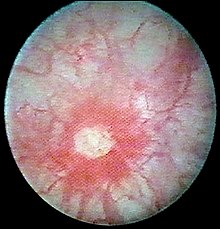
Back متلازمة المثانة المؤلمة Arabic Interstitielle Zystitis German Διάμεση κυστίτιδα Greek Cistitis intersticial Spanish Interstitiaalinen virtsarakon tulehdus Finnish Cystite interstitielle French Cistite intersticial Galician תסמונת שלפוחית השתן הכאובה HE Hólyagfájdalom szindróma Hungarian Cistite interstiziale Italian
| Interstitial cystitis | |
|---|---|
| Other names | Bladder pain syndrome (BPS),[1] painful bladder syndrome (PBS), IC/BPS, IC/PBS, UCPPS[2] |
 | |
| Hunner's lesion seen in some interstitial cystitis patients by cystoscopy[3][4] | |
| Pronunciation | |
| Specialty | Urology |
| Symptoms | Chronic pain of the bladder, feeling the need to urinate right away, needing to urinate often, pain with sex[1] |
| Complications | Depression, irritable bowel syndrome, fibromyalgia[1][5] |
| Usual onset | Middle age[1] |
| Duration | Long term[1] |
| Causes | Unknown[1] |
| Diagnostic method | Based on the symptoms after ruling out other conditions[5] |
| Differential diagnosis | Urinary tract infection, overactive bladder, sexually transmitted infections, endometriosis, bladder cancer, prostatitis[1][6] |
| Treatment | Lifestyle changes, medications, procedures[1] |
| Medication | Ibuprofen, pentosan polysulfate, amitriptyline[1] |
| Frequency | 0.5% of people[1][5] |
Interstitial cystitis (IC), a type of bladder pain syndrome (BPS), is chronic pain in the bladder and pelvic floor of unknown cause.[1] It is the urologic chronic pelvic pain syndrome of women.[2] Symptoms include feeling the need to urinate right away, needing to urinate often, and pain with sex.[1] IC/BPS is associated with depression and lower quality of life.[5] Many of those affected also have irritable bowel syndrome and fibromyalgia.[1]
The cause of interstitial cystitis is unknown.[1] While it can, it does not typically run in a family.[1] The diagnosis is usually based on the symptoms after ruling out other conditions.[5] Typically the urine culture is negative.[5] Ulceration or inflammation may be seen on cystoscopy.[5] Other conditions which can produce similar symptoms include overactive bladder, urinary tract infection (UTI), sexually transmitted infections, prostatitis, endometriosis in females, and bladder cancer.[1][6]
There is no cure for interstitial cystitis and management of this condition can be challenging.[1] Treatments that may improve symptoms include lifestyle changes, medications, or procedures.[1] Lifestyle changes may include stopping smoking and reducing stress.[1] Medications may include ibuprofen, pentosan polysulfate, or amitriptyline.[1] Procedures may include bladder distention, nerve stimulation, or surgery.[1] Kegel exercises and long term antibiotics are not recommended.[5]
In the United States and Europe, it is estimated that around 0.5% of people are affected.[1][5] Women are affected about five times as often as men.[1] Onset is typically in middle age.[1] The term "interstitial cystitis" first came into use in 1887.[7]
- ^ a b c d e f g h i j k l m n o p q r s t u v w x "Interstitial cystitis/bladder pain syndrome fact sheet". OWH. 16 July 2012. Archived from the original on 5 October 2016. Retrieved 6 October 2016.
- ^ a b Adamian L, Urits I, Orhurhu V, Hoyt D, Driessen R, Freeman JA, Kaye AD, Kaye RJ, Garcia AJ, Cornett EM, Viswanath O (May 2020). "A Comprehensive Review of the Diagnosis, Treatment, and Management of Urologic Chronic Pelvic Pain Syndrome". Curr Pain Headache Rep. 24 (6): 27. doi:10.1007/s11916-020-00857-9. PMID 32378039. S2CID 218513050.
- ^ Persu C, Cauni V, Gutue S, Blaj I, Jinga V, Geavlete P (2010). "From interstitial cystitis to chronic pelvic pain". Journal of Medicine and Life. 3 (2): 167–74. PMC 3019050. PMID 20968203.
- ^ Stedman TL (2005). Stedman's Medical Eponyms. Lippincott Williams & Wilkins. p. 344. ISBN 9780781754439.
- ^ a b c d e f g h i Hanno PM, Erickson D, Moldwin R, Faraday MM, American Urological A (May 2015). "Diagnosis and treatment of interstitial cystitis/bladder pain syndrome: AUA guideline amendment". The Journal of Urology. 193 (5): 1545–53. doi:10.1016/j.juro.2015.01.086. PMID 25623737. Archived from the original on 20 April 2014.
- ^ a b Bogart LM, Berry SH, Clemens JQ (2007). "Symptoms of interstitial cystitis, painful bladder syndrome and similar diseases in women: a systematic review". The Journal of Urology. 177 (2): 450–456. doi:10.1016/j.juro.2006.09.032. PMID 17222607. S2CID 14482415.
- ^ Bostwick DG, Cheng L (2014). Urologic Surgical Pathology (3 ed.). Elsevier Health Sciences. p. 208. ISBN 9780323086196. Archived from the original on 9 October 2016.
© MMXXIII Rich X Search. We shall prevail. All rights reserved. Rich X Search